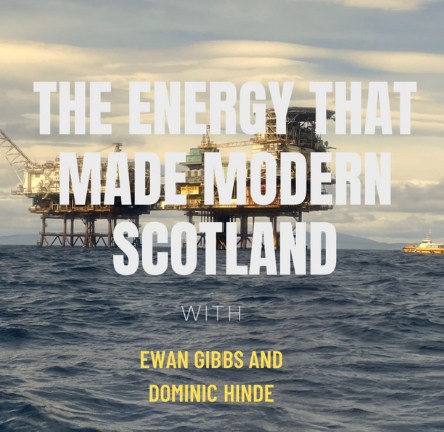The Energy that Made Modern Scotland
Published: 4 April 2025
3 April 2025: Dr Ewan Gibbs introduces his new podcast The Energy that Made Modern Scotland, co-hosted with UofG colleague Dr Dominic Hinde, which brings to life the story of North Sea energy through archive clips, expert interviews and academic analysis.
Blog by Dr Ewan Gibbs, Senior Lecturer in Economic and Social History
The Chemical Brothers were booming out of the surprisingly powerful stereo of Dom’s small ageing Honda as we passed the sun-kissed Cromarty Firth. It was June 2024, and it was an unusually sunny day in the Eastern Highlands. Techno felt appropriate though. Oil rigs in various states of repair and decommissioning bobbed in the Firth and at Nigg the fabrication yard was filled with large parts of wind turbines.
When I’d last been in Easter Ross, I’d interviewed older men and women who had moved to the area in the 1970s. They were part of a movement of people and labour that brought tens of thousands of workers and their families to the area. When shipyards were shuttering in Glasgow, Greenock and Dundee there were new opportunities in the Highlands building oil rigs at the fabrication yard which still services the industry and stores parts for the burgeoning offshore wind sector.
Dom and I were bound for further North, to Wick. We’d eventually convinced the skipper of a small rubber boat to take us offshore to see the now decommissioned Beatrice oil platforms and the growing offshore wind farms in the Moray Firth. Even on a temperate day in June, we ended up drenched and freezing, and Dom’s microphone took a battering.
It was well worth the cold though. Dom and I have both been researching Scotland’s energy system for years. The trip to Wick was the culmination of a longstanding ambition to see the rigs and the turbines we’d been writing and speaking to people about. And it was an exciting way to give the listeners of our new audio documentary, The Energy that Made Modern Scotland, a stronger idea of what these structures look, sound and feel like.
Our documentary was dreamt up over years of conversations, and a growing realisation that we had visited the same places - especially in the Highlands and Shetland – but met different people and asked different questions.
As a historian, I spend my time in archives, understanding how local and national government, private and nationalised industries and trade unions responded to the challenges and opportunities of oil and gas. I have also recorded interviews with current and former workers and their families and others living through the shift towards renewables to understand how earlier experiences are shaping contemporary expectations.
Dom’s recent research has reprised his journalism skills along with his sociological thinking. He has been observing people in situ, including around the Eastern highlands, in the helicopter terminals in Aberdeenshire which take offshore workers to the rigs and around the shrinking but still present oil and gas industry in Shetland.
Our documentary tells the story of the transformations to Scottish society, politics and culture brought by fifty years of oil and gas production and the twenty-first century renewables revolution. We concentrate on the communities of Northern Scotland which have been front and centre of these changes and felt them most powerfully.
Over five short parts, in an approximately one-hour programme, listeners will be introduced to the hopes which the discovery of North Sea oil animated in the 1970s. After this, we visit Shetland, hearing from people who lived through the building of Europe’s biggest oil and gas terminal in the 1970s and 1980s reflecting on the longer-term impact of oil revenues. Shetland is often written about as an oil success story. Our interviewees are less certain, pointing to achievements, limitations and concerns wind will not offer the same local revenues.
Part three takes us to Nigg, where memories of the heyday of oil rig fabrication in the 1970s and 1980s animate memories of high wages and shipyard workers from across the UK descending on Easter Ross. Cromarty remains central to hopes for Scotland’s wind industry, but outcomes have been comparatively disappointing.
The fourth episode takes us offshore, following our maritime journey out to Beatrice and centring on the scale of oil and renewable engineering achievements they reveal. Conversely though, the benefits locally and nationally are arguably far less decisive. The final part builds on this discussion, asking why energy abundance hasn’t made Scotland a fairer or more affluent society.
Our aim has been to create a listenable programme with a potential public audience. We view this as a contribution to a societal conversation and we have privileged voices from Northern Scotland for that reason. Too often, the people and places at the heart of the energy sector have been absent from the discussion on its past, present and future.
LISTEN to The Energy that Made Modern Scotland on Spotify
Author
Dr Ewan Gibbs is a Senior Lecturer in the School of Social and Political Sciences at the University of Glasgow, and is a historian of energy, industry, work and protest.
His work explores how the production and consumption of energy has pivotally shaped employment, politics and economic change. He uses historical insights to frame and explore contemporary debates around achieving a just transition towards a sustainable economy for workers and communities embedded in carbon industries.
Image by Ewan Gibbs
First published: 4 April 2025


